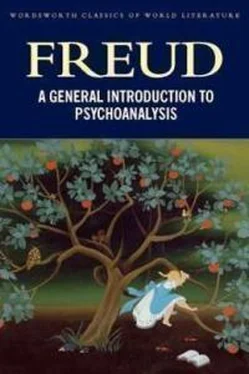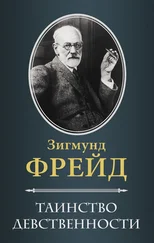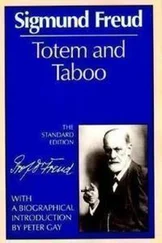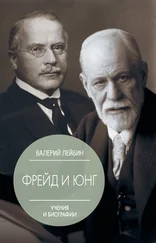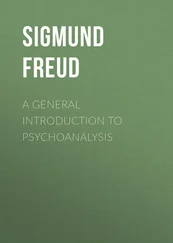And so you cannot explain the therapeutic influence of psychoanalysis by saying that it simply recommends giving full sway to sexuality. You must seek another solution. I think that while I was refuting this supposition of yours, one of my remarks put you on the right track. Our usefulness consists in replacing the unconscious by the conscious, in translating the unconscious into the conscious. You are right; that is exactly it. By projecting the unconscious into the conscious, we do away with suppressions, we remove conditions of symptom formation and transform a pathogenic into a normal conflict which can be decided in some way or other. This is the only psychic change we produce in our patients; its extent is the extent of our helpfulness. Wherever no suppression and no analogous psychic process can be undone, there is no place for our therapy.
We can express the aim of our efforts by various formulae of rendering the unconscious conscious, removing suppressions, filling out amnestic gaps—it all amounts to the same thing. But perhaps this admission does not satisfy you. You imagined that when a nervous person became cured something very different happened, that after having been subjected to the laborious process of psychoanalysis, he was transformed into a different human being. And now I tell you that the entire result is only that he has a little less of the unconscious, a little more of the conscious within him. Well, you probably underestimate the significance of such an inner change. The person cured of neurosis has really become another human being. Fundamentally, of course, he has remained the same. That is to say, he has only become what he might have been under the most favorable conditions. But that is saying a great deal. When you learn all that has to be done, the effort required to effect apparently so slight a change in psychic life, the significance of such a difference in the psychic realm will be credible to you.
I shall digress for a moment to ask whether you know what is meant by a causal therapy? This name is given to the procedure which does not take the manifestations of disease for its point of departure, but seeks to remove the causes of disease. Is our psychoanalytical therapy causal or not? The answer is not simple, but perhaps it will give us the opportunity of convincing ourselves that this point of departure is comparatively fruitless. In so far as analytical therapy does not concern itself immediately with the removal of symptoms, it may be termed causal. Yet in another respect, you might say this would hardly follow. For we have followed the causal chain back far beyond the suppressions to the instinctive tendencies and their relative intensity as given by the constitution of the patient, and finally the nature of the digression in the abnormal process of its development. Assume for a moment that it were possible to influence these functions chemically, to increase or to decrease the quantity of the libido that happens to be present, to strengthen one impulse at the expense of another. This would be causal therapy in its true sense and our analysis would have furnished the indispensable preparatory work of reconnaissance. You know that there is as yet no possibility of so influencing the processes of the libido. Our psychic therapy interposes elsewhere, not exactly at those sources of the phenomena which have been disclosed to us, but sufficiently far beyond the symptoms, at an opening in the structure of the disease which has become accessible to us by means of peculiar conditions.
What must we do in order to replace the unconscious by the conscious in our patient? At one time we thought this was quite simple, that all we had to do was to reconstruct the unconscious and then tell the patient about it. But we already know this was a shortsighted error. Our knowledge of the unconscious has not the same value as his; if we communicate our knowledge to him it will not stand in place of the unconscious within him, but will exist beside it, and only a very small change will have been effected. We must rather think of the unconscious as localized , and must seek it in memory at the point where it came into existence by means of a suppression. This suppression must be removed before the substitution of the conscious for the unconscious can be successfully effected. How can such a suppression be removed? Here our task enters a second phase. First to find the suppression, then to remove the resistance by which this suppression is maintained.
How can we do away with resistance? In the same way—by reconstructing it and confronting the patient with it. For resistance arises from suppression, from the very suppression which we are trying to break up, or from an earlier one. It has been established by the counter–attack that was instigated to suppress the offensive impulse. And so now we do the very thing we intended at the outset: interpret, reconstruct, communicate—but now we do it in the right place. The counter–seizure of the idea or resistance is not part of the unconscious but of the ego, which is our fellow–worker. This holds true even if resistance is not conscious. We know that the difficulty arises from the ambiguity of the word "unconscious," which may connote either a phenomenon or a system. That seems very difficult, but it is only a repetition, isn't it? We were prepared for it a long time ago. We expect resistance to be relinquished, the counter–siege to collapse, when our interpretation has enabled the ego to recognize it. With what impulses are we able to work in such a case? In the first place, the patient's desire to become well, which has led him to accommodate himself to co–operate with us in the task of the cure; in the second place, the help of his intelligence, which is supported by the interpretation we offer him. There is no doubt that after we have made clear to him what he may expect, the patient's intelligence can identify resistances, and find their translation into the suppressions more readily. If I say to you, "Look up into the sky, you can see a balloon there," you will find it more readily than if I had just asked you to look up to see whether you could discover anything. And unless the student who for the first time works with a microscope is told by his teacher what he may look for, he will not see anything, even if it is present and quite visible.
And now for the fact! In a large number of forms of nervous illness, in hysteria, conditions of anxiety and compulsion neuroses, one hypothesis is correct. By finding the suppression, revealing resistance, interpreting the thing suppressed, we really succeed in solving the problem, in overcoming resistance, in removing suppression, in transforming the unconscious into the conscious. While doing this we gain the clearest impression of the violent struggle that takes place in the patient's soul for the subjugation of resistance—a normal psychological struggle, in one psychic sphere between the motives that wish to maintain the counter–siege and those which are willing to give it up. The former are the old motives that at one time effected suppression; among the latter are those that have recently entered the conflict, to decide it, we trust, in the sense we favor. We have succeeded in reviving the old conflict of the suppression, in reopening the case that had already been decided. The new material we contribute consists in the first place of the warning, that the former solution of the conflict had led to illness, and the promise that another will pave the way to health; secondly, the powerful change of all conditions since the time of that first rejection. At that time the ego had been weak, infantile and may have had reason to denounce the claims of the libido as if they were dangerous. Today it is strong, experienced and is supported by the assistance of the physician. And so we may expect to guide the revived conflict to a better issue than a suppression, and in hysteria, fear and compulsion neuroses, as I have said before, success justifies our claims.
Читать дальше
